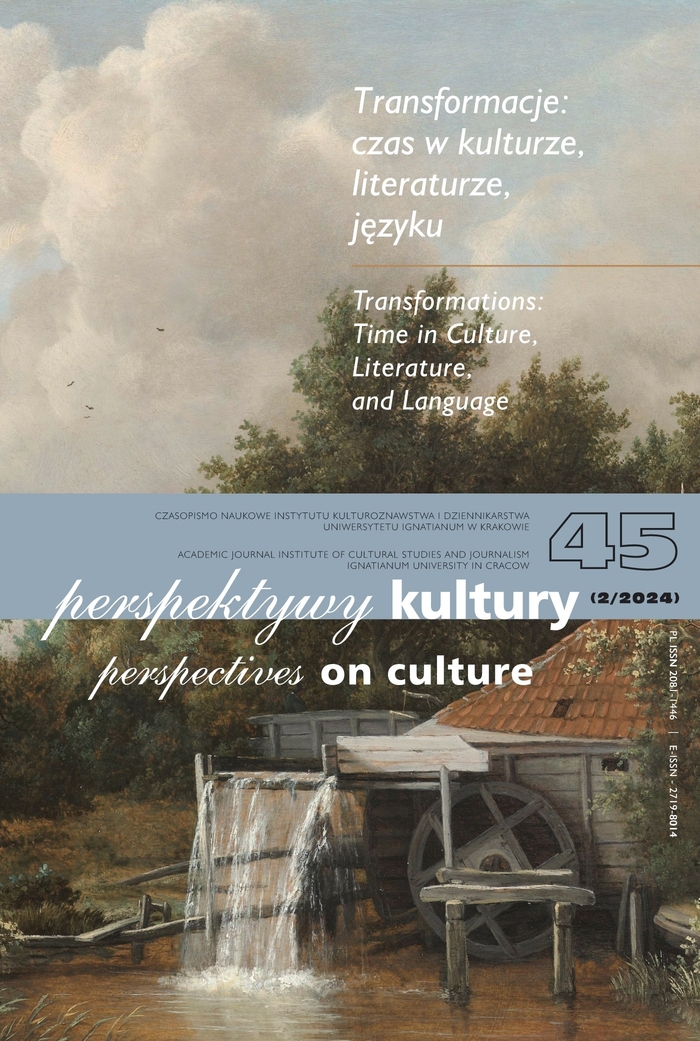Joseph Conrad – władca czasu
Abstrakt
Conrad w sposób nowatorski wykorzystuje kategorię czasu w swych utworach. Stosując takie narzędzia jak opóźnione dekodowanie, retrospekcje, przesunięcia czasowe, a także wprowadzając swoich bohaterów w pętlę czasową lub pozbawioną czasu przestrzeń, pisarz wyprzedzał swoją epokę. W jego dziełach czas przeczy prawom fizyki, pozwalając mu tworzyć idiosynkratyczną czasoprzestrzeń.
Bibliografia
References to Conrad’s works are to the Cambridge Edition of the Works of Joseph Conrad. All the references are abbreviated as follows: “Heart of Darkness,” HD; Lord Jim, LJ; Notes on Life and Letters, NLL; A Personal Record, PR; The Secret Agent, SA.
Conrad, J. (1972). Nostromo. A Tale of the Seaboard, ed. N. Sherry. London: Dent, abbreviated N.
Conrad, J. (1975). Tomorrow. In: The Nigger of the ‘Narcissus’,Typhoon and other Stories. Harmondsworth: Penguin Books, 333–359, abbreviated T. Alford, C.F. (2016). Levinas, trauma, and God: Does Emmanuel Levinas idealize trauma? Retrieved from: https://www.traumatheory.com/tag/cathy-caruth/ (access: 10.09.2023).
Blanco, M. del Pilar & Peeren, E. (2013). Intorduction: Conceptualizing Spectralities. In: M. del Pilar Blanco & E. Peeren (eds.), The Spectralities Reader. Ghosts and Haunting in Contemporary Cultural Theory. London, New York: Bloomsbury, 1–27.
Bernstein, J.A. (2012). “No Audible Tick”: Conrad, McTaggart, and the Revolt against Time. The Conradian, no. 1(37), 32–45.
Caruth, C. (1995). Trauma and Experience: Introduction. In: Trauma. Explorations in Memory. Baltimore and London: The Johns Hopkins UP, 3–12. Derrida, J. & Stiegler, B. (2013). Spectrographies. In: M. del Pilar Blanco & E. Peeren (eds.), The Spectralities Reader. Ghosts and Haunting in Contemporary Cultural Theory. London, New York: Bloomsbury 37–51.
Gillihan, S.J. (2016). 21 Common Reactions to Trauma. Retrieved from: https:// www.psychologytoday.com/us/blog/think-act-be/201609/21-common-rea- ctions-trauma (access: 12.09.2023).
Kertzer, J.M. (1979). Joseph Conrad and the Metaphysics of Time. Studies in the Novel, no. 3 (11), 302–317.
Knowles, O. & Moore, G. (2000). Oxford Reader’s Companion to Conrad. Oxford, New York: Oxford UP.
Najder, Z. (1997). Conrad in Perspective. Essays on Art and Fidelity. Cambridge: Cambridge UP.
Najder, Z. (1996). Wstęp. In: J. Conrad-Korzeniowski, Lord Jim. Wrocław, Warszawa, Kraków: Zakład Narodowy Imienia Ossolińskich, V–XCVI.
Stolorow, R.D. (2015). Trauma Destroys Time. Retrieved from: https://www. psychologytoday.com/us/blog/feeling-relating-existing/201510/trauma-destroys-time (access: 07.09.2023). Tanner, T. (1963). Conrad: Lord Jim.
Watt, I. (1980). Conrad in the Nineteenth Century. London: Chatto and Windus.
Copyright (c) 2024 Perspektywy Kultury

Utwór dostępny jest na licencji Creative Commons Uznanie autorstwa – Bez utworów zależnych 4.0 Międzynarodowe.
Autor, zgłaszając swój artykuł, wyraża zgodę na korzystanie przez Wydawnictwo Uniwersystet Ignatianum z utworu na następujących polach eksploatacji:
- utrwalania utworu w formie papierowej, a także na nośniku cyfrowym lub magnetycznym;
- zwielokrotnienia utworu dowolną techniką, bez ograniczenia ilości wydań i liczby egzemplarzy;
- rozpowszechniania utworu i jego zwielokrotnionych egzemplarzy na jakimkolwiek nośniku, w tym wprowadzenia do obrotu, sprzedaży, użyczenia, najmu;
- wprowadzenia utworu do pamięci komputera;
- rozpowszechniania utworu w sieciach informatycznych, w tym w sieci Internet;
- publicznego wykonania, wystawienia, wyświetlenia, odtworzenia oraz nadawania i reemitowania, a także publicznego udostępniania utworu w taki sposób, aby każdy mógł mieć do niego dostęp w miejscu i czasie przez siebie wybranym.
Wydawca zobowiązuje się szanować osobiste prawa autorskie do utworu.





